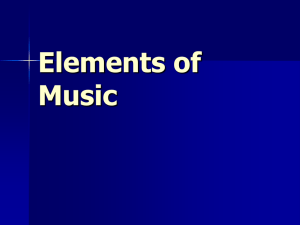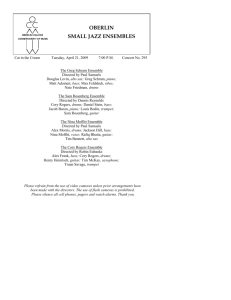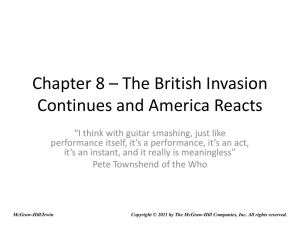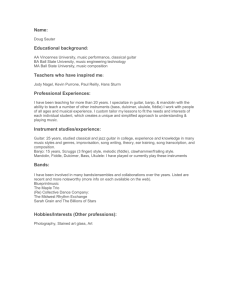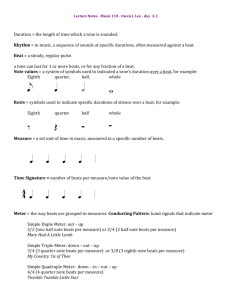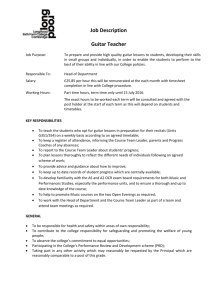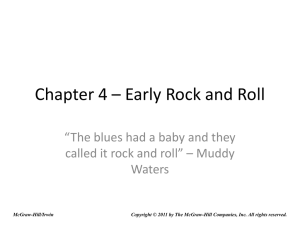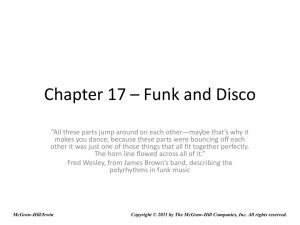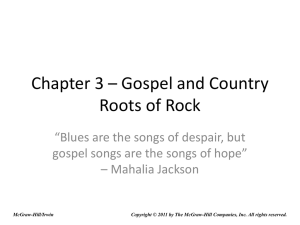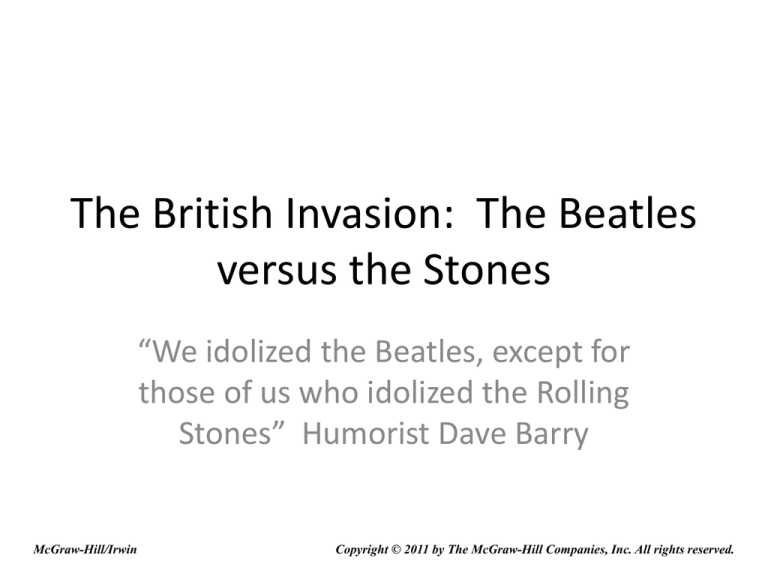
The British Invasion: The Beatles
versus the Stones
“We idolized the Beatles, except for
those of us who idolized the Rolling
Stones” Humorist Dave Barry
McGraw-Hill/Irwin
Copyright © 2011 by The McGraw-Hill Companies, Inc. All rights reserved.
The Beatles
“Mersey beat” from Liverpool and Manchester
Skiffle and Buddy Holly influenced early sound
Clean image, matching suits, heeled boots
John Lennon (1940-1980), singer, songwriter, rhythm guitarist
Paul McCartney (born in 1942), singer, songwriter, electric bass
guitar and keyboards
George Harrison (1943-2001), singer, songwriter, lead guitarist,
sitarist
Ringo Starr (born in 1940), singer, drummer
Temporary members include Stu Sutcliffe and Pete Best
Brian Epstein, manager
George Martin, principal producer
7-2
Beatles’ music in three periods:
1) Skiffle and Pop-influenced love songs (19571964)
2) Dylan-influenced introspective songs (19651966)
3) Studio concentration without touring (19671969)
7-3
Listening Guide
“I Want to Hold Your Hand” by the Beatles (1964)
Tempo: 132 beats per minute, 4 beats per bar
Form: 8-bar sections, with 4-bar refrains, some extensions
Features: Downbeat not clear until vocals begin
Even beat subdivisions
Backbeat in drums
Instrumentation, electric lead and rhythm guitars, electric bass
guitar, and drums
No instrumental solos
Hand-clapped pattern creates polyrhythmic effect
Lyrics: Hand holding demonstrates a deeper connection with
beloved
Charts: Pop, #1 for seven weeks, British hits, #1 for five weeks
7-4
Listening Guide
“Norwegian Wood” by the Beatles (1965)
Tempo: 3-beat bars in waltz rhythm, with downbeats
at 60 per minute
Form: 8-bar phrases
Features: Vocals are gentle and dreamy
Primary accompaniment instruments are acoustic
rhythm guitar and sitar with bass and
tambourine
The sitar stands out because of bent notes
Lyrics: A cryptic story about an affair of John Lennon’s
7-5
Listening Guide
“A Day in the Life” by the Beatles (1967)
Tempo: 76 beats per minute, 4 beats per bar, but B section twice as
fast
Form: Sections in unequal lengths, ordered AAABA
Features: Even beat subdivisions
Drums support rhythms, no backbeat
Instruments include strummed acoustic guitar, electric bass,
piano, drums, and, before the B section, a forty-piece
orchestra recorded and overdubbed four times to
create a sound mass
End with a long extension of a echo of the final piano chord
Lyrics: A sections include various different images described by
John Lennon, B section about ordinary life that includes drug use by
Paul McCartney
7-6
The Rolling Stones
Rhythm & Blues band from London
Casual dress and style
Early songs included covers, original songs by 1965
Mick Jagger (born in 1943), singer, songwriter
Keith Richard (born in 1943), guitarist, songwriter
Brian Jones (1942-1969), guitarist, multiinstrumentalist
Bill Wyman (born in 1936), electric bass guitar
Charlie Watts (born in 1941), drums
Also, Ian Stewart, pianist on some recordings
Andrew Oldham, manager
7-7
Listening Guide
“Not Fade Away” by Buddy Holly (1957)
Tempo: 184 beats per minute, 4 beats per bar
Form: 8-bar stanzas
Features: Drums keep a soft “Bo Diddley” beat
Backbeat not prominent, some stop time
used
Backup vocal group imitates the beat
Lyrics: Holly sings as if he were politely informing
a girl that she will eventually be his
7-8
Listening Guide
“Not Fade Away” by the Rolling Stones (1964)
Tempo: 208 beats per minute, 4 beats per bar
Form: Similar to Buddy Holly’s original recording
Features: The Bo Diddley beat is stressed
Maracas keep even beat subdivisions, as Bo Diddley often did
in his own recordings
Tambourine adds a black gospel feel
The backbeat is not prominent
No stop time is used
Blues harp (harmonica) adds some blues color
Lyrics: Jagger’s vocal tone, singing Holly’s same lyrics, sounds more
demanding, and even arrogant, in his pronouncement that the
girl will soon be his
7-9
Listening Guide
“(I Can’t Get No) Satisfaction” by the Rolling Stones (1965)
Tempo: 138 beats per minute, 4 beats per bar
Form: 8 or 16 bar sections with some extensions
Features: 2-bar opening riff played four times before vocals enter
Riff played on guitar though a Gibson Maestro fuzzbox to
sound somewhat like a saxophone
Instruments include electric bass guitar, drums, tambourine,
and acoustic guitar
Drums play steady beat with little backbeat
Lyrics: The song is about a desire for sex and frustration with
commercial advertising
Charts: Pop, #1 for four weeks, R&B, # 19, British hits, #1
7-10
Rolling Stones Membership Changes
Brian Jones quit in 1969 and died soon after
Mick Taylor (born in 1948), Jones’ replacement
on guitar
Mick Taylor quit in 1975
Ron Wood (born in 1947), Taylor’s replacement
on guitar
Bill Wyman quit in 1989
Darryl Jones, Wyman’s replacement on electric
bass guitar
7-11
Listening Guide
“Miss You” by the Rolling Stones (1978)
Tempo: 112 beats per minute, 4 beats per bar
Form: 4-bar phrases
Four instrumental sections vary in length
Features: Uneven beat subdivisions
Steady pulse in drums, some emphasis on backbeat
Jagger’s vocals change from soft and subtle to an effective
imitation of African American “jive talk” as he mimics
a friend’s voice on the phone
Lyrics: The singer is obsessed by how much he misses the
person to whom the song is directed
Charts: Pop, #1, R&B, #33, British hits, #3
7-12
Discussion questions
What was it about the American social, political,
and musical situations in the early sixties that
made the country so ready for invasion by the
British bands?
Were the Beatles and the Rolling Stones so great
that they could have taken over the U.S. charts
any time, or was it mostly a case of good timing
that they became so popular so quickly?
7-13

